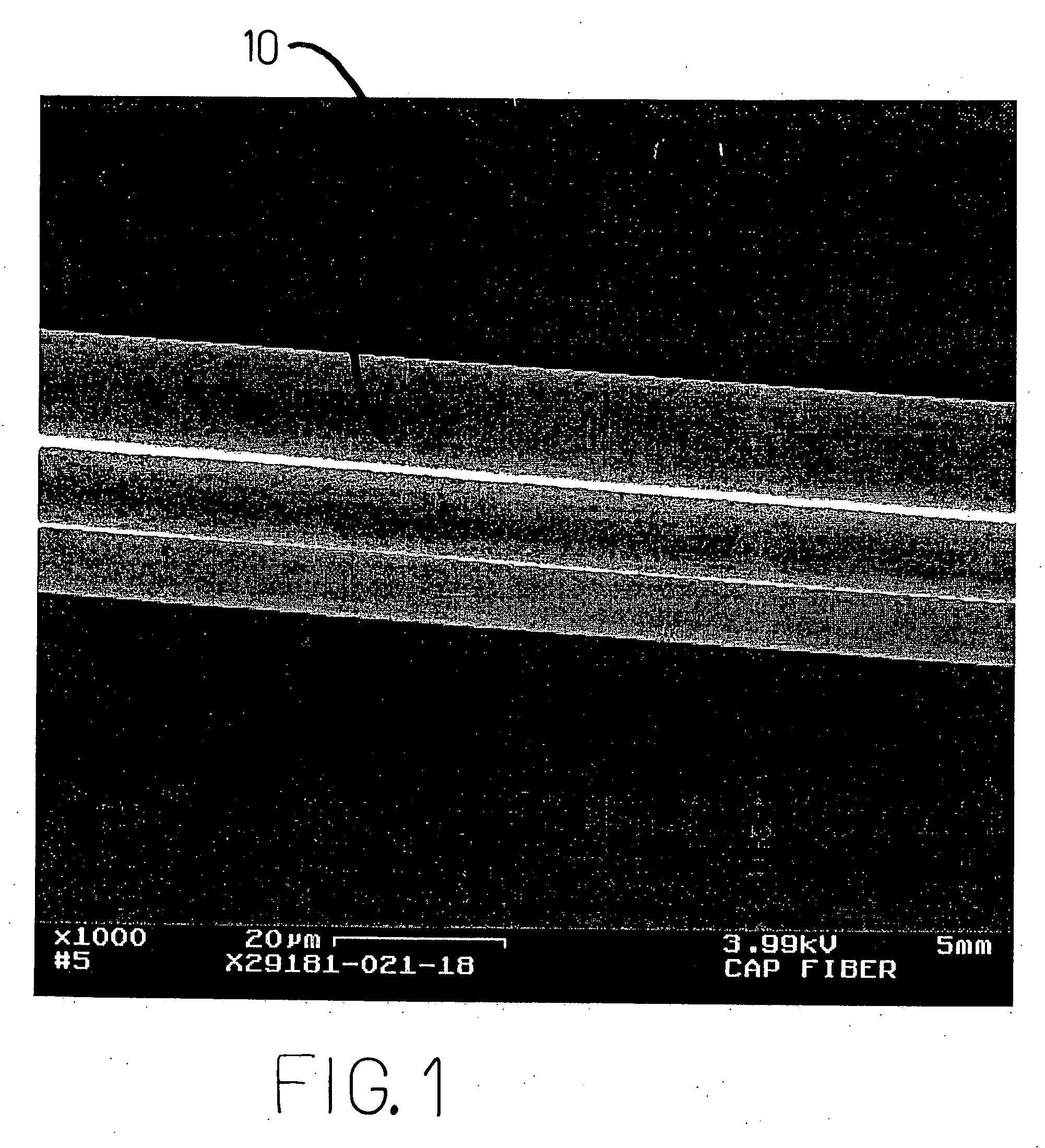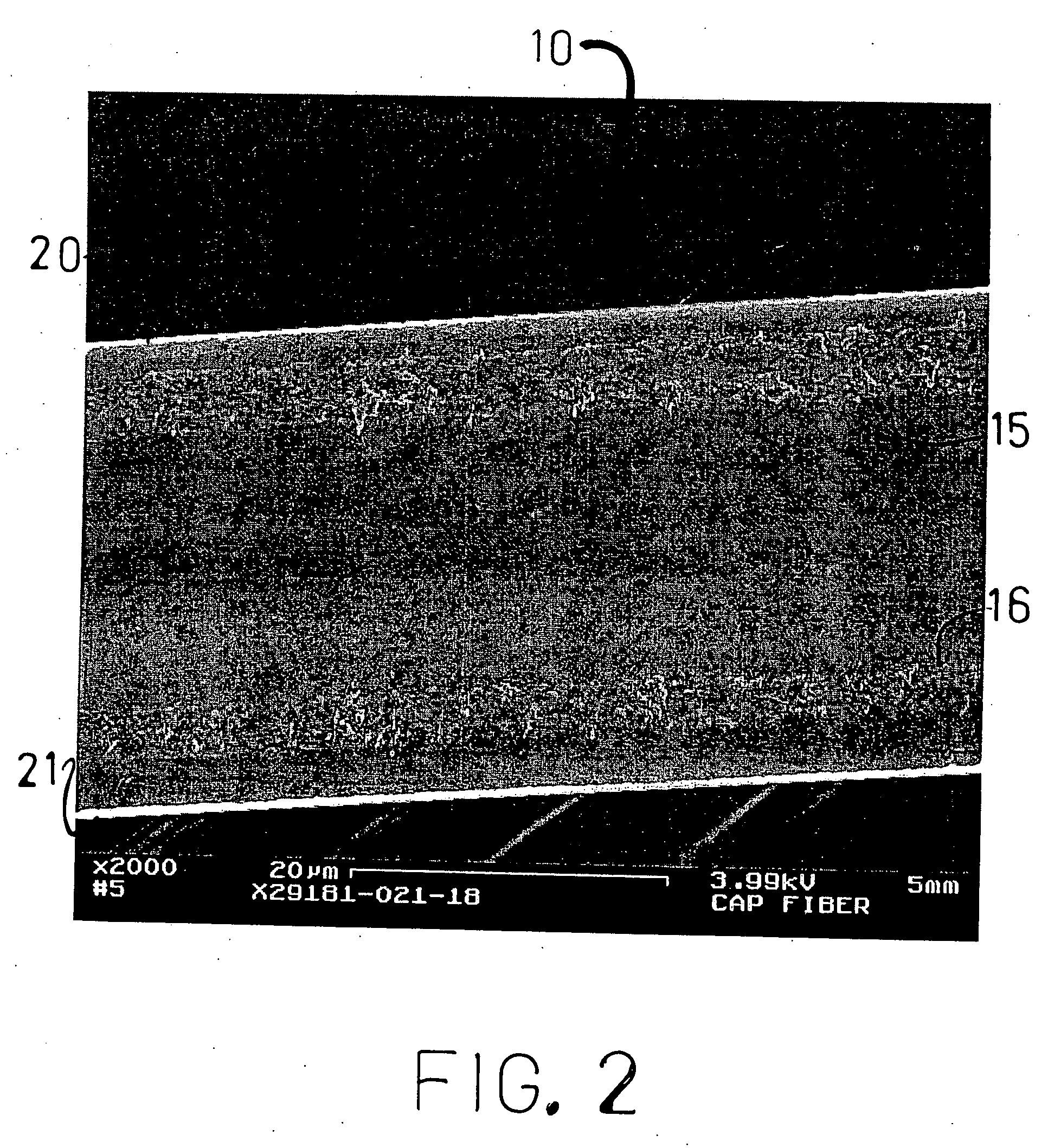Hollow-core fibers
- Summary
- Abstract
- Description
- Claims
- Application Information
AI Technical Summary
Benefits of technology
Problems solved by technology
Method used
Image
Examples
examples 1-7
[0053] The materials specified in Table 1 below were tested using 3 inch (7.6 cm) swatches of material exposed to an aerosol challenge of Staphylococcus aureus (ATCC #6538) which was repeatedly delivered to each test material over a two minute interval. The technique was modified from NLI standard BFE test to provide a challenge level of greater than 1×106 colony forming units (CFU) / test article. The flow rate through the test article was maintained at 30 L / min. (1.1 cubic feet / min (CFM)). The face velocity, determined by the flow rate divided by the surface area, was maintained at 22 feet per minute (6.7 meters / min) unless specified otherwise.
[0054] In preparing the aerosol challenge of Staphylococcus aureus, 100 ml of soybean casein was inoculated with the bacterium and incubated at 37° C. (±2° C.) for 24 hours (±4 hours) with mild shaking. An amount of the inoculated soybean casein was diluted with peptone water to achieve an aerosol challenge concentration of greater than 1×10...
examples 8-14
[0060] In examples 8-14 the general procedures as set forth above for Examples 1-7 were following, with the following exceptions. The challenge organism was bacteriophage phi-X174 (ATCC #13706B1) incorporated into Escherichia coli (E. coli C, ATCC #13706), a coliform as the host for the virus.
[0061] To prepare the phi-X174 bacteriophage, approximately 100 mL of a nutrient broth was inoculated with E. coli C and incubated for about 6-18 hours at 37° C. (±2° C.) with stirring at about 200-250 rpm. A 1:100 dilution of the E. coli C culture was prepared and incubated at 37° C. (±2° C.) with stirring at about 200-250 rpm to grow a culture having a density of 2-4×108 CFU / mL. This density corresponded to an optical density of 0.3-0.5 on a spectrophotometer at 640 nanometers.
[0062] The E. coli C bacteria culture was then inoculated with 5-10 mL of the bacteriophage phi-X174 so that the ratio of bacteriophage to bacteria cells would be between 0.1 to 2.0. The mixture was incubated for abou...
examples 15-17
[0067] In the following Examples, tests were conducted in multiples of 5 samples each and the average of the absorbency reported. In performing the test, fiber samples weighing approximately 5±0.05 grams were placed in a 316 stainless steel basket having dimensions of 23 mm in diameter, 37 mm deep and weighting 9.003 grams. The basket was held above the surface of the water, at a temperature of 25 °±1° C., at a distance of about 12 mm. The basket was lowered into the water and allowed to completely submerge. The basket was then removed from the water and allowed to drain for 10 seconds. The basket and fibers were then weighed. The weight of the test basket and fibers was deducted from this weight to determine the amount of water absorbed by the fibers. The results are in Table III below.
TABLE IIIExample No.Fiber denier% Weight Gain154.31980165.11978176.11888
[0068] As can be seen from Table III, the hollow-core fibers of the present invention have a significant absorptive capacity....
PUM
| Property | Measurement | Unit |
|---|---|---|
| Fraction | aaaaa | aaaaa |
| Fraction | aaaaa | aaaaa |
| Fraction | aaaaa | aaaaa |
Abstract
Description
Claims
Application Information
 Login to View More
Login to View More - R&D
- Intellectual Property
- Life Sciences
- Materials
- Tech Scout
- Unparalleled Data Quality
- Higher Quality Content
- 60% Fewer Hallucinations
Browse by: Latest US Patents, China's latest patents, Technical Efficacy Thesaurus, Application Domain, Technology Topic, Popular Technical Reports.
© 2025 PatSnap. All rights reserved.Legal|Privacy policy|Modern Slavery Act Transparency Statement|Sitemap|About US| Contact US: help@patsnap.com



